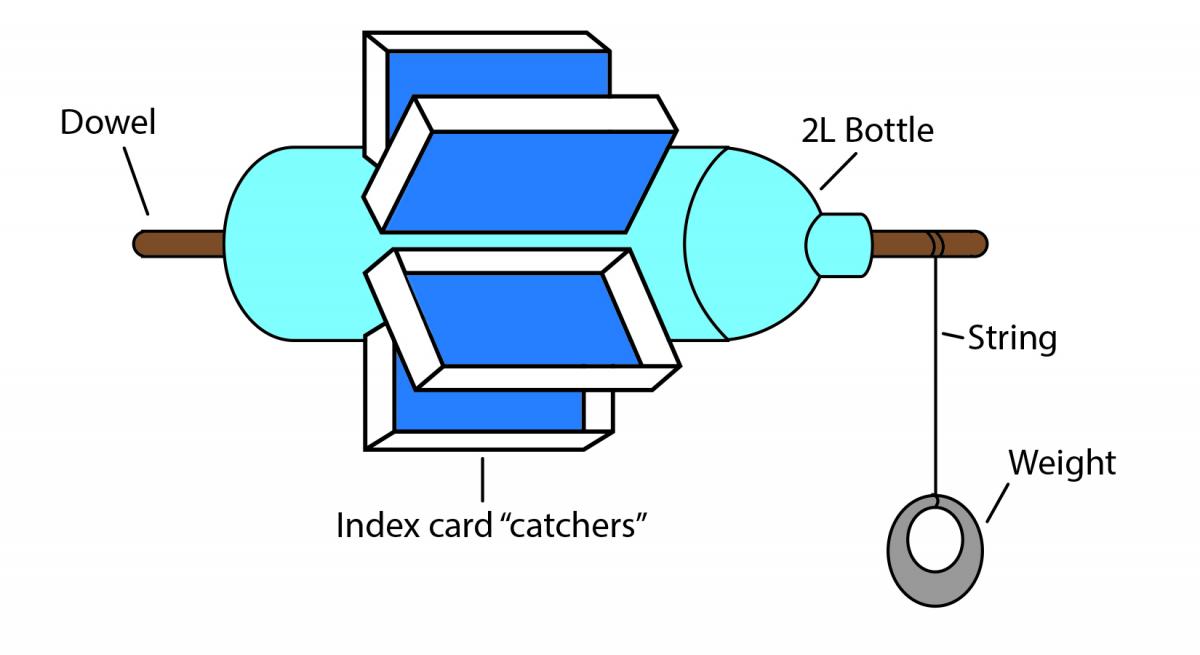Waterwheel Works
Learning Objectives
Students will investigate how water can be used as a form of energy
Associated Curriculum Topic
Energy in Our Lives
Materials
Each group needs:
- 1 empty, clean two-liter plastic soda bottle (ask students to bring from home)
- 1 pair of scissors
- Tape
- 6-8 large index cards
- Pen or marker
- Wooden dowel, ~¾-inch (2 cm) diameter (to fit into the bottle opening with a little room to turn) and longer than the length of the soda bottle
- String
For the entire class to share:
- Source of water and pouring container (to hold ~ 2 liters water)
- Sink (or outside area that can get wet)
Introduction/Motivation
This activity provides an illustration of hydropower, a renewable energy resource. Hydro means water, so hydropower is something that gets power from water. Hydropower captures energy from the movement of water. In particular, a waterwheel is a machine that uses and produces hydropower. A waterwheel spins around as a stream of water, which is being pulled down by gravity, hits its paddles or blades. Waterwheels use the energy of moving water to perform many types of mechanical work. Waterwheels were used to power farm equipment, drive pumps, trip hammers, saw timber, grind grains into flour, make iron products, and power textile mills. Before the development of steam power, waterwheels were the only sources of power (besides human or animal power). Often, towns were built close to a river so waterwheels could be built nearby.
Procedure
Divide the class into teams of three or four students each, providing work space for each. Alternatively you could consider building one waterwheel together as a class project.

Figure 1. Assembly diagram for the plastic bottle waterwheel. (Copyright © Malinda Schaefer Zarske, ITL Program, University of Colorado at Boulder, 2005.)
- With the pen or marker, draw 6 to 8 lengthwise lines in equal distances from each other around the large plastic bottle. These mark the locations where index card "water catchers" will be taped.
- Fold the index cards to make small boxes or envelopes ("catchers"). These will serve as waterwheel paddles (or buckets or blades) to catch the water.
- Tape the index card "catchers" to the soda bottle at each line. Make sure each catcher is facing the same direction.
- Make a hole in the bottom of the bottle, to accept the dowel and allow it to spin. Insert the dowel into the opening of the soda bottle as an axle.
- Test waterwheels by pouring water on them (over a sink or outside).
- Have teams fasten a string to the neck of their waterwheel. Tie classroom objects (paperclips, erasers, …) to the string so the spinning waterwheel pulls them up as the string rolls around the neck of the bottle. (Conduct this step over a sink or outside.)
Investigating Questions
How are waterwheels (hydromills) and windmills similar? (Answer: Both have "vanes" and a turbine shaft, and both generate renewable energy.)
What happened to the waterwheel as you poured water on it?
What happens to the waterwheel if the water is flowing quickly? slowly?
What happened when we added weight? What happened to the rate of turning?
Ask students to describe, in general terms, how hydropower works.
Adapted from Teach Engineering